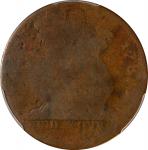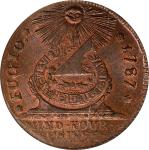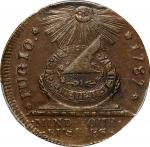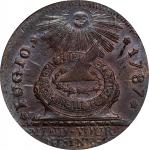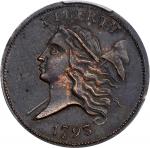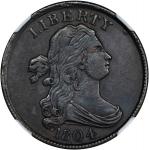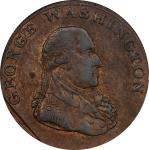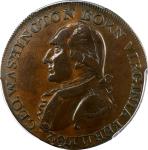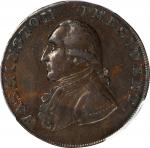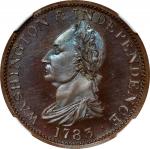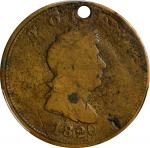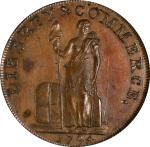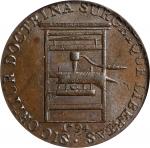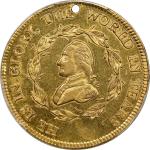1799 (ca. 1800) Washington Funeral Urn Medal. Musante GW-70, Baker-166, Fuld Dies 1-B. Gold. AU-58 (PCGS).29.5 mm. Neatly pierced at 12 oclock, as usual. Rich golden-olive surfaces are accented by traces of soft orange-apricot iridescence. Considerable traces of the original prooflike character of the fields are retained on both sides. Clearly handled and worn as an adornment, but evidence for this is minimal and confined to trivial high point rub and some wispy marks. The overall sharpness and eye appeal are quite excellent, in fact, this being much sharper than the former Ford Collection example that was sold in the April 2021 Partrick sale, for just over $50,000. It is also sharper at centers than Syd Martins specimen that was certified AU-53 by PCGS and netted $66,000 in our Winter (November) 2022 Auction.
This one is from an earlier state than the Martin specimen, without the long crack passing from rim to rim from just below and left of the urns base to just over the G at 10 oclock. On the obverse, die state evidence consists of a hairline crack over the letter A in TEARS that connects to the upper left corner of the adjacent R. Circular roughness around the suspension piercing is suggestive of some type of hanger that gently abraded the gold, and this is not a feature one would expect to see from any sort of collector strike. Similarly, the edges, rims and high points exhibit a trace of legitimate wear.
The earliest appearance we are aware of for a Funeral Urn medal in gold was W. Elliot Woodwards April 1863 sale, where one was secured by a Mrs. Paige for $55. Woodward commented that "very few specimens exist in this metal" and that it is "of the most extreme rarity," the latter italicized for emphasis. Two years later, Woodward would describe another of these for sale, including the comment, "a splendid original." Though no further discussion on the point was made at this lot, it is clear that a question had arisen as to the status of these medals. The following year, he described yet another, the Hoffman specimen, by which point it seems that the controversy surrounding them had boiled over. Woodward declared here that "several of these pieces have, from time to time, been sold as genuine, but it is now known that they are counterfeits, the dies having been in the possession of the late Dr. Edwards; they are now destroyed, together with all the pieces struck from them, excepting the few mentioned as having been sold to collectors." The next to sell was cataloged by Edward Cogan in April 1866, for Colin Lightbody. That was noted as "guaranteed original, and very rare."
It is difficult to know with certainty just what transpired, and it is easy to imagine that once the dies were discovered in Dr. Edwards possession, Woodward (and others?) might have been too hasty in condemning them all. Jacob Perkins is known to have struck gold Washington funeral medals. An undated, but circa 1800 advertisement reprinted on page 140 of Neil Musantes work, <em>Medallic Washington</em>, clearly illustrates that Perkins struck gold medals of Washington, and these, specifically for the ladies, have been taken to refer to the oval gold shells that are known to have been placed into lockets (as suggested directly by the advertisement). It is likely, therefore, that wealthy men of Boston or Newburyport might have wished gold impressions of Perkins funeral medals for themselves and ordered them. The evidence, though circumstantial it may be, suggests that there are originals and restrikes, potentially of both Urns and Skull and Crossbones medals in existence, though they may not be distinguishable. Die states do exist, but this can only be used to sequence struck pieces via direct comparison. It cant reliably point to an original versus a restrike as steel dies can and do break early, sometimes before they strike a single piece. This gold impression is certainly from an earlier state of the dies than at least one other (see above), and it is also notable that the die rotation matches that seen on most other Urns.
The dies were cut by the esteemed engraver Jacob Perkins, of Newburyport, Massachusetts, and are believed to have been struck by him and distributed at or for the civic funeral procession held in Boston. As every town seems to have set aside its own day for memorial tributes, typically including well-planned processions, it is quite possible that Perkins could have capitalized on the opportunity in several nearby towns, if his work was complete in time. Processions are noted by us to have happened in Marblehead on January 2, Hallowell on January 8, Medford on January 13, and Haverhill on February 22. Certainly, there were many more. The number of dies prepared and the different compositions suggests a fairly large output. There were at least seven obverse dies and seven reverses used on medals bearing the funeral urn motif.
Gold funeral medals have long been markers of the greatest collections, as only the most advanced cabinets tend to include this most precious composition. Historic collections that included them go back to at least the 1860s, and include owners such as Colin Lightbody (1865), Francis Hoffman (1866), Colin Lightbody (a second one, in 1866), Charles Ira Bushnell (1882), Sylvester Crosby (1883), Lorin G. Parmelee (1890), Matthew Stickney (1907), Charles Gregory (1916), and W.W.C. Wilson (1925).
We have sold many of them, and yet our online archives include just a single example in gold - the aforementioned Syd Martin specimen - as most of our past offerings are approaching two decades old by now. We recall specimens in our Garrett (1981), Steinberg (1992), LaRiviere (1999), Western Reserve (2003) and John J. Ford, Jr. sales (2004), the latter including a remarkable four specimens!
Of greater significance is the fact that this issue in gold was missing from the landmark 2006 Norweb offerings (which did, however, include a gold Skull and Crossbones), our Charles Wharton Collection sale in 2014, our several recent sales from the E Pluribus Unum Collection and, perhaps most notably, our presentation of the William Spohn Baker Collection, on behalf of the Historical Society of Pennsylvania, in 2019.Ex Gilbert G. Steinberg, privately; Anthony Terranova.




